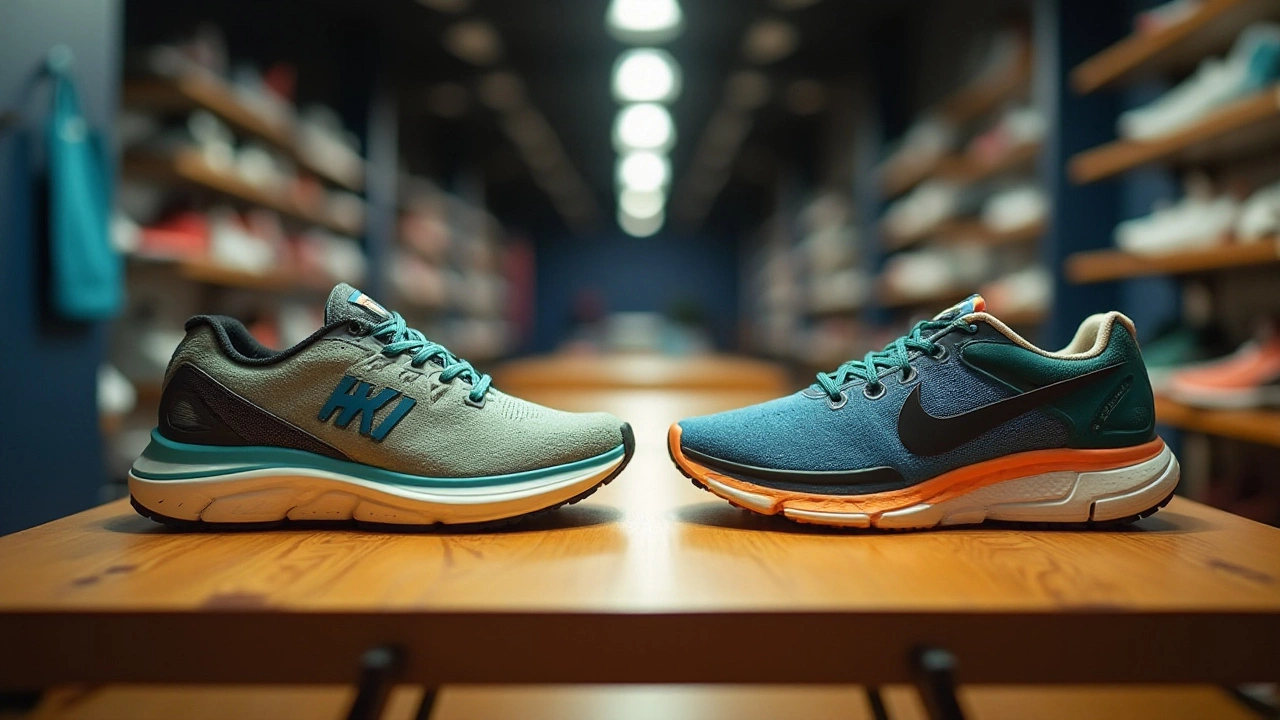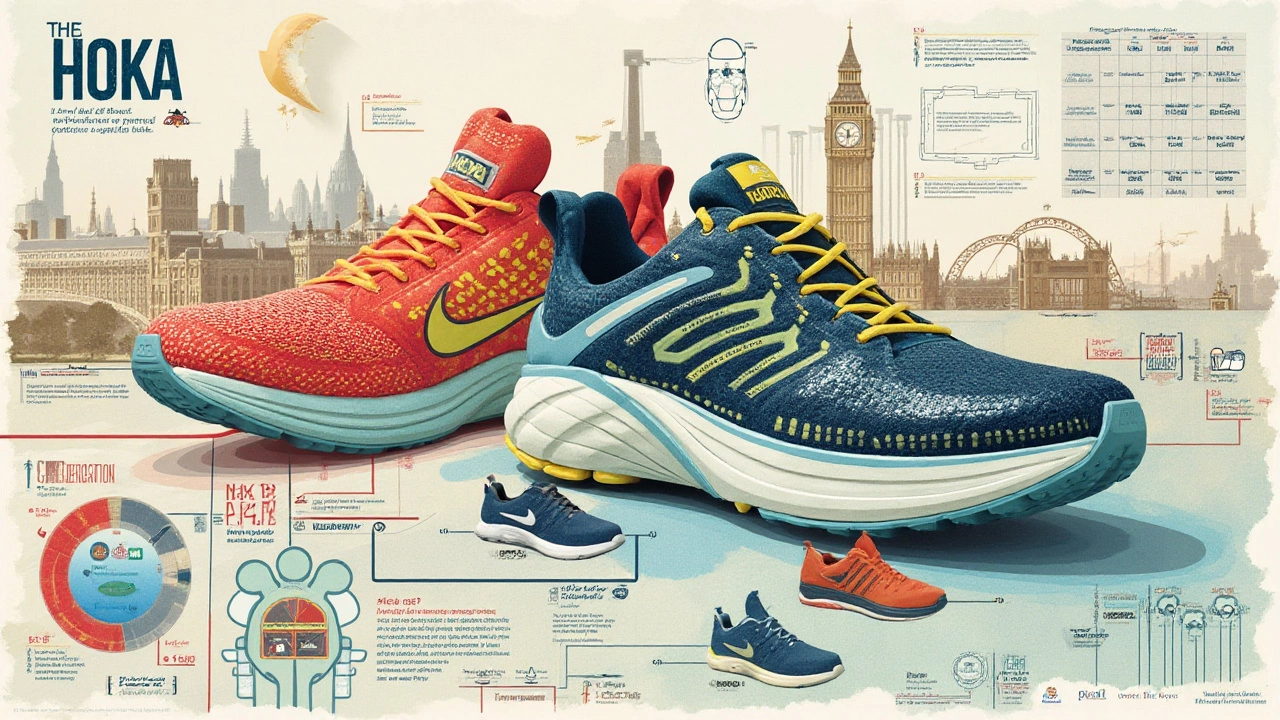Is HOKA Under Nike's Ownership? A 2025 Insight into Running Shoe Brands
 Jan, 17 2025
Jan, 17 2025
In the vibrant world of running shoes, where innovation meets performance, a common query often arises: Is HOKA owned by Nike? This question surfaces among enthusiasts and casual runners alike, intrigued by the origins and affiliations of their favorite footwear.
To clear the air, HOKA, celebrated for its unique and comfortable designs, remains independent of Nike's ownership. Instead, this brand finds its roots within the house of Deckers Brands. This exploration will uncover how these two distinctive names hold their ground in the dynamic marketplace, each crafting its legacy with unique philosophies and engineered craftsmanship.
Stay with us to navigate through the trails of these iconic brands, which reveal much more than meets the eye—and discover how each step they take impacts the world of running shoes.
- The Rise of HOKA: A Brief History
- Nike's Influence in the Running Shoe Market
- HOKA's Distinctive Approach
- Ownership Details: Who Owns HOKA?
- Comparing HOKA and Nike: Key Differences
- Future Prospects for HOKA and Nike
The Rise of HOKA: A Brief History
Founded in 2009 by Jean-Luc Diard and Nicolas Mermoud, HOKA emerged from the unassuming backdrop of outdoor sports enthusiasts yearning for an enhanced running experience. Both Diard and Mermoud hailed from the picturesque landscapes of Annecy, France, where the mountains dictated the tempo of life and adventure beckoned persistently. The duo sought to revolutionize how runners interacted with the terrain beneath them, challenging the conventional wisdom that less was more in running shoes.
Their pioneering vision birthed the concept of maximalist shoes—a stark contrast to the minimalist trend rampant in that era. It was this radical idea that put HOKA on the map, capturing the attention of endurance runners looking for extra cushioning and support. Their shoes featured an oversized outsole, significantly larger than the norm, with an intention to provide stability and cushioning to absorb the shock impacts runners faced. From their debut model, the Mafate, HOKA shoes were lauded for their unconventional appearance coupled with spectacular performance enhancements.
In 2013, their potential caught the eye of Deckers Brands, a move that propelled HOKA to new heights. As part of the Deckers portfolio, HOKA maintained its commitment to engineering high-performance shoes. This partnership enabled HOKA to expand globally, making their innovative designs accessible to a broader audience, and enhanced their brand presence exponentially. Speaking of this transformative phase, a renowned industry insider once quoted,
"HOKA managed to carve a niche for themselves not by following the trends but by redefining them entirely."
As the years rolled on, HOKA continued to push boundaries. They introduced a range of versatile styles catering not just to trail runners, but also to road runners and everyday users. The brand became synonymous with comfort and support, cherished by enthusiasts and professionals alike. They understood that the needs of runners were diverse, and HOKA placed itself at the heart of these experiences, ensuring each shoe was an answer to a runner's unique challenges.
In recent years, the global running shoe market has shown impressive growth. To put this into perspective, here's a potential snapshot of market shares reflecting HOKA's influence:
| Year | Market Share (%) of HOKA | Remark |
|---|---|---|
| 2015 | 3% | Early Riser |
| 2020 | 7% | Expanding Horizons |
| 2025 | 10% | Solidified Presence |
The journey from a small French start-up to a global leader in running technology is a testament to how innovation and resilience can pave the way for success. They did not just create shoes; they invented a new philosophy of running. This quintessence is what makes HOKA a brand that runners around the globe have embraced wholeheartedly, and it continues to fuel their strides into the future.
Nike's Influence in the Running Shoe Market
Nike's journey in the running shoe market is a tale of innovation, strategic marketing, and resilience. Since the company's inception back in the early 1960s, Nike has been a synonym for sports excellence. Over the decades, the brand has not only shaped the athletic footwear industry but also set trends that reverberate across the globe. Nike's philosophy of constant innovation has led to the development of cutting-edge technologies like Nike Air, Flyknit, and React foam, which continue to push the boundaries of what running shoes can offer in terms of comfort, performance, and style.
The popularity of products such as the Nike Pegasus and the Air Zoom Alphafly NEXT% illustrates Nike's ability to marry performance with hype, making their shoes a coveted possession for both elite athletes and everyday runners. Nike’s influence in the running community goes beyond just providing footwear; its sponsorship of prominent athletes and events cements its status as an industry leader. The brand's strategic partnerships with world-class runners like Eliud Kipchoge—who made history in the marathon—serve as a testament to Nike’s dominance and ambition. Kipchoge’s sub-two-hour marathon run in 2019 was achieved wearing Nike’s revolutionary Vaporfly shoes, showcasing how Nike continues to push human potential through their innovations.
Investments in marketing have also played a pivotal role in boosting Nike’s visibility and relevance. Campaigns like 'Just Do It' resonate with the emotions and aspirations of athletes of all levels, turning a slogan into a global mantra. With a presence in sports culture that extends beyond shoes to clothing and equipment, Nike influences lifestyle trends as well. According to a recent report, Nike held a significant share of the global athletic footwear market, underlining its stature in the industry. The integration of technology, such as the Nike Run Club app, offers users personalized coaching and motivational tools, further embedding Nike into the running narrative.
"Nike epitomizes the intersection of sport and innovation, constantly redefining what athletes can achieve with the right gear," says John Donahoe, CEO of Nike. This approach has allowed Nike to maintain its competitive edge and command respect within the market.
For those curious about the numbers, a 2023 market analysis highlighted that Nike's revenue from footwear alone accounted for a large portion of its over forty billion-dollar annual revenue. This dominance is illustrated by their ability to meet the needs of diverse groups, from professional athletes to fitness enthusiasts. It's a testament to how Nike has been able to position itself not just as a supplier of physical products but as a curator of the athletic experience. Their continuous innovations reiterate how the brand adapts to trends while setting new benchmarks in the industry, making them the gold standard by which other brands, including HOKA, often measure themselves.

HOKA's Distinctive Approach
When discussing the landscape of running shoes, HOKA stands out not only for its unique aesthetics but also for its philosophy that challenges traditional footwear norms. Originating from France in 2009, HOKA's approach has always been about enhancing the runner's experience through comfort and innovation. The brand gained attention with its oversized midsoles, which sparked curiosity and skepticism alike. Yet, the design proved revolutionary, offering unmatched cushioning that absorbed shock while providing stability, a feature avid runners soon appreciated.
The essence of HOKA's innovation lies in its mission to empower runners of all abilities, promoting every activity's enjoyment and achievement. By using lightweight materials, HOKA struck a balance between cushioning and responsiveness, shaving off unnecessary weight without compromising performance. The brand's motto, "Time to Fly," encapsulates this ethos, inviting athletes to experience the sensation of enhancing their strides and reducing fatigue. Underpinning their efforts is a dedication to research and feedback-driven refinement, ensuring each product iteration surpasses its predecessor in quality and technological advancement.
One aspect that sets HOKA apart is its commitment to experimentation. The rocker midsole—a signature feature—encourages a rolling gait, naturally propelling the runner forward. There's an intriguing dynamism in how the shoe interacts with the foot and ground, providing a smooth transition from heel to toe. It's a winning formula that marries comfort with function, resonating with both seasoned and new runners. An array of styles and colors also caters to diverse aesthetic preferences without sacrificing performance.
In the pursuit of sustainability, HOKA joins the ranks of innovation-driven brands introducing eco-conscious manufacturing processes. There is an increasing focus on using recycled materials without compromising the product's integrity, a step towards reducing ecological footprints. HOKA also collaborates with numerous athletes and everyday users to continually test and refine their products, ensuring real-world applicability and satisfaction. It's a reflection of a brand willing to evolve and listen to its community.
Moreover, those who have experienced HOKA often cite their unique sensation and unrivaled comfort. As one enthusiastic testimonial in a running magazine stated,
"HOKA has redefined what it feels like to run long distances. It's like running on clouds—lightweight, yet perfectly balanced."This kind of customer-driven testament has bolstered HOKA's reputation in an industry where word-of-mouth and authentic experiences matter greatly.
This commitment to both performance and comfort makes HOKA a brand that has successfully carved out its niche in an often crowded market. When facing competitors like Nike, HOKA's approach is about innovation rather than imitation, setting a standard that appeals to runners seeking a fresh perspective. In recent years, HOKA's market presence has grown substantially, evidenced by its expanding global reach and an increase in sales, charting a promising trajectory for the future.
Ownership Details: Who Owns HOKA?
The ownership of HOKA is a tale of strategic growth and thoughtful market positioning, nestled within the broader narrative of modern athletic footwear. The brand was founded in 2009 by two expatriates from the world of Salomon—a company known for its trail shoes—Jean-Luc Diard and Nicolas Mermoud. They embarked on a mission to create a shoe that would allow runners to descend mountains with greater speed and comfort, sparking the birth of their revolutionary shoe designs. Recognized for its oversized soles and enhanced cushioning, HOKA quickly gained a cult following among ultra-marathoners and casual runners seeking unmatched comfort.
As of today, HOKA operates under the aegis of Deckers Brands, a company that acquired it in April 2013. Deckers is a renowned global player in the footwear industry, recognized for housing other prominent brands such as UGG and Teva. The acquisition by Deckers was a strategic move aimed at expanding their portfolio into the increasingly popular segment of maximalist running shoes, which HOKA pioneered. This relationship with Deckers allowed HOKA to benefit from increased resources and reach while maintaining the essence that made the brand unique.
Though Nike looms large as a dominant force in the athletic world, they do not own HOKA. Nike, headquartered in Beaverton, Oregon, has an array of well-known brands, yet HOKA operates outside of its extensive empire. This independence allows HOKA to indulge in its niche market without the pressure of conforming to the mainstream athletic narrative. Interestingly, Deckers Brands' foresight in nurturing HOKA's burgeoning appeal amid a crowded field of running shoe brands has proven to be profitable. In fiscal year 2022, Deckers Brands reported net sales of $3.15 billion, with a significant portion attributed to the growing popularity of HOKA.
"HOKA's growth trajectory showcases the value of innovation in a competitive industry. They've taken significant strides in a crowded market," notes Zachary Dillinger, an industry analyst at a leading financial firm.
This success story highlights the importance of autonomy in fostering innovation. While some might speculate on HOKA joining forces with a giant like Nike, the brand remains committed to its core values of maximizing runner comfort and performance independent of external ownership. It’s a tale of embracing the underdog spirit in a realm dominated by giants, offering solace to runners who appreciate the elevated design and distinct flair. The independence from Nike not only permits HOKA to tailor to its dedicated followers but also provides the agility needed to swiftly adapt to emerging trends in the athletic industry.

Comparing HOKA and Nike: Key Differences
When placed side by side, HOKA and Nike exhibit distinct characteristics that resonate with different types of runners. These nuances in design philosophy, technology, and branding encapsulate what makes each company unique. HOKA emerged in the world of running shoes with its remarkable, maximalist design, where oversized midsoles are a trademark. This approach prioritizes cushioning and comfort over everything else, which is especially appealing to trail runners and long-distance athletes who crave that extra comfort and shock absorption. Its signature high-stack sole provides not just impact protection, but promotes a
Future Prospects for HOKA and Nike
As the athletic footwear market races into new horizons, both HOKA and Nike have their eyes set on paths laden with potential. HOKA, a brand known for its flamboyant, thick-soled shoes, continues to push the envelope with technological advancements aimed at curating a distinctive running experience. The brand’s commitment to innovation is mirrored by its pursuit of sustainability; one can expect an increase in eco-friendly materials, which aligns with a global shift towards greener production practices. This conscious choice attracts a demographic whose purchasing decisions are increasingly influenced by environmental considerations.
Nike, on the other hand, retains its position as a market titan through its relentless emphasis on branding and versatile product lines. Their dominance stems not just from technology, but the emotional connection they forge with consumers. Nike’s strategy pivots around inclusivity and personalization. With initiatives such as digital shoe customization, the company empowers customers to personalize their footwear, creating a highly individualized product that feels unique to their narrative. According to a report from Statista, Nike aims to maintain a stronghold in the digital realm by bolstering its online sales, projected to reach 50% of its total revenue by 2025.
Nike CEO, John Donahoe, once mentioned, "At our core, Nike is a growth company driven by our purpose to unite the world through sport to create a healthy planet, active communities, and an equal playing field for all."
Strategically, collaboration remains a hallmark for both HOKA and Nike. While HOKA delves deeper into niche sports partnerships, like trail running, to reinforce its specialty footwear segment, Nike widens its scope through collaborations crossing over into fashion and technology. These partnerships open doors to fresh markets and audiences, ensuring continual brand evolution and customer engagement.
The competitive landscape promises robust development through the innovation pipeline. HOKA is likely to leverage its competitive edge in cushioning and support, expanding its reach into casual and lifestyle segments, thereby broadening its consumer base. Retail strategies, including expanded global footprints, feature prominently in both companies’ blueprints, reflecting an understanding that accessibility and availability often equate to increased market share.
Market analysts predict that running shoes will maintain high demand, given the increasing awareness around health and fitness. The forecast paints an encouraging picture for HOKA and Nike, where adaptability and foresight could mean striking gold in an industry that thrives on breaking boundaries. The future is an invitation both brands are eager to RSVP to, equipped not just with innovation and market acumen but a narrative that resonates with values consumers hold dear.